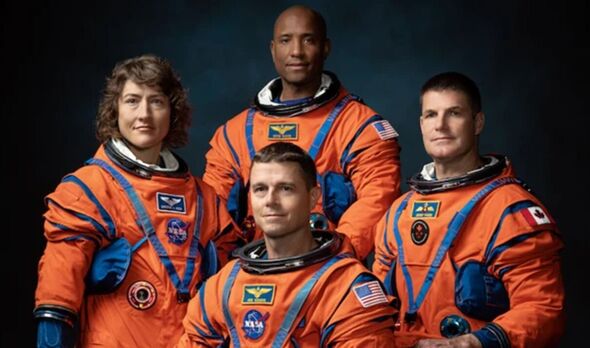Science
NASA Selects Astronauts for Historic Return to the Moon

NASA has announced the selection of ten new astronauts, marking a significant step towards humanity’s return to the Moon through the Artemis program. This historic announcement comes after a competitive process involving over 8,000 applicants and represents the 24th group of astronauts since the Mercury Seven in 1959. Notably, for the first time, more women have been selected than men, highlighting a growing commitment to diversity in space exploration.
The Apollo missions, which took place between 1961 and 1972, remain a cornerstone of human achievement in space. The landmark Apollo 11 mission in 1969 saw astronauts Neil Armstrong and Buzz Aldrin become the first humans to walk on the lunar surface, a moment immortalized by Armstrong’s famous words: “That’s one small step for man, one giant leap for mankind.” Over six missions, a total of 12 astronauts explored the Moon, gathering invaluable samples and conducting experiments that expanded our understanding of the cosmos. Apollo 17, which occurred in 1972, marked the final crewed lunar mission as NASA shifted its focus to projects in low-Earth orbit, including the Space Shuttle and the International Space Station.
After decades of limited lunar exploration, the Artemis program aims to reignite interest in the Moon with ambitious goals. These include landing the first woman and the first black person on the Moon, alongside establishing a sustainable human presence as a precursor for future missions to Mars.
The newly selected astronauts bring diverse expertise to the program. One astronaut is a geologist who contributed to the Curiosity Mars rover project, providing critical insights into planetary surfaces vital for both lunar and Martian explorations. Another member of the group, a SpaceX engineer, participated in a mission that achieved the world’s first private spacewalk, illustrating the increasing importance of commercial space ventures. Additionally, a former SpaceX launch director joins the class, bringing a wealth of operational experience from an organization that has transformed space travel.
This selection reflects NASA’s strategy to integrate scientific rigor with cutting-edge industry experience, ensuring the astronauts are well-prepared for the challenges of deep-space exploration. The astronauts will engage in two years of intensive training at NASA’s Johnson Space Center in Houston, where they will develop skills in spacewalking, operating the Orion spacecraft, and surviving in extreme environments. Following their training, they will join the 41 active U.S. astronauts and may soon participate in Artemis missions, potentially setting foot on the Moon within months.
Acting NASA Administrator Sean Duffy has suggested that these astronauts could also be among the first humans to reach Mars. This ambition aligns with the broader aspirations of the space community, including those of Elon Musk, the founder of SpaceX. Musk envisions colonizing Mars and establishing a self-sustaining city by 2050, leveraging SpaceX’s Starship, a reusable rocket designed for human and cargo transportation to the Red Planet.
While NASA’s timeline remains more measured, focusing on lunar missions throughout the 2020s before targeting Mars in the 2030s or 2040s, partnerships with SpaceX highlight a shared objective of extending human presence beyond Earth. NASA’s astronaut selection process is highly competitive, with only 370 individuals chosen in its 66-year history, making this latest class an exceptional group that notably alters the long-standing gender balance within the corps.
Flight operations director Norm Knight commended the new astronauts as “distinguished” and “exceptional,” emphasizing the rigorous nature of the selection process. The Artemis program aims to construct a lunar gateway and surface habitats, allowing for extended stays and scientific research on the Moon. This infrastructure will serve as a testing ground for technologies essential for Mars exploration, where challenges such as radiation exposure, distance, and resource limitations will demand innovative solutions.
As the Artemis program approaches its first crewed lunar landing, this new class of astronauts symbolizes hope for a transformative era in exploration. Their endeavors could redefine humanity’s role in the cosmos, bridging the historic achievements of Apollo with a future where Mars becomes a viable second home for humankind.
-

 Entertainment3 months ago
Entertainment3 months agoAnn Ming Reflects on ITV’s ‘I Fought the Law’ Drama
-

 Entertainment4 months ago
Entertainment4 months agoKate Garraway Sells £2 Million Home Amid Financial Struggles
-

 Health3 months ago
Health3 months agoKatie Price Faces New Health Concerns After Cancer Symptoms Resurface
-

 Entertainment3 months ago
Entertainment3 months agoCoronation Street’s Carl Webster Faces Trouble with New Affairs
-

 Entertainment3 months ago
Entertainment3 months agoWhere is Tinder Swindler Simon Leviev? Latest Updates Revealed
-

 Entertainment4 months ago
Entertainment4 months agoMarkiplier Addresses AI Controversy During Livestream Response
-

 Science1 month ago
Science1 month agoBrian Cox Addresses Claims of Alien Probe in 3I/ATLAS Discovery
-

 World2 weeks ago
World2 weeks agoBailey Announces Heartbreaking Split from Rebecca After Reunion
-

 Health4 months ago
Health4 months agoCarol Vorderman Reflects on Health Scare and Family Support
-

 Entertainment4 months ago
Entertainment4 months agoKim Cattrall Posts Cryptic Message After HBO’s Sequel Cancellation
-

 Entertainment3 months ago
Entertainment3 months agoOlivia Attwood Opens Up About Fallout with Former Best Friend
-

 Entertainment2 weeks ago
Entertainment2 weeks agoCoronation Street Fans React as Todd Faces Heartbreaking Choice





















